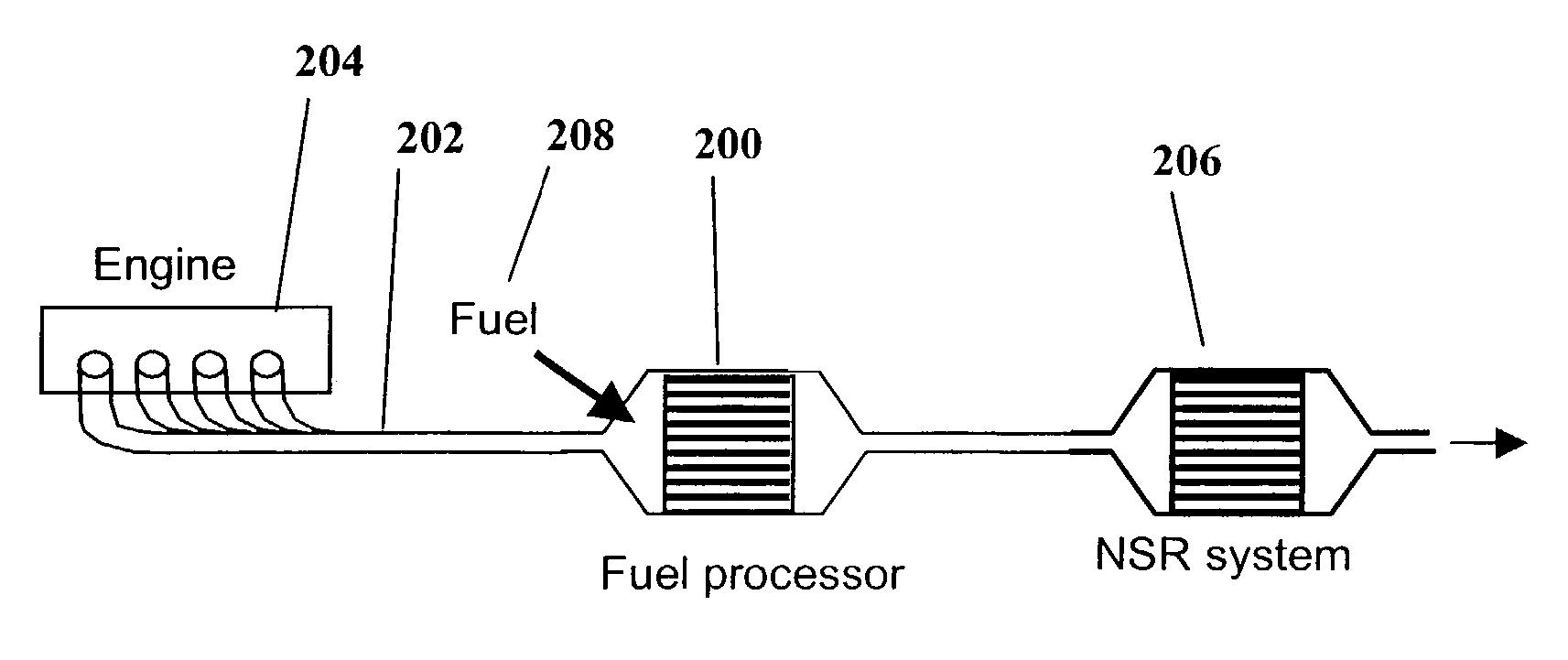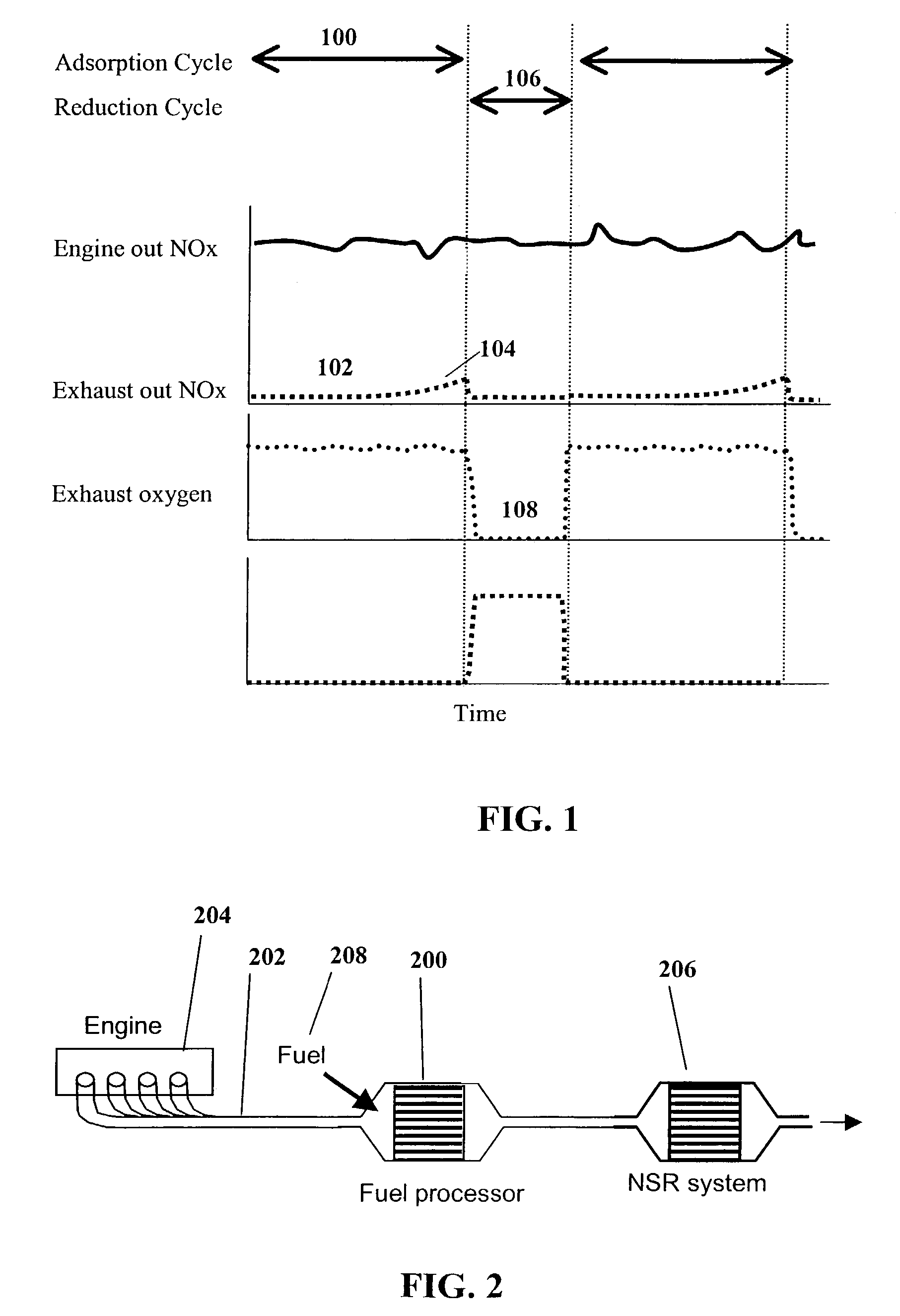System and methods for improved emission control of internal combustion engines
- Summary
- Abstract
- Description
- Claims
- Application Information
AI Technical Summary
Benefits of technology
Problems solved by technology
Method used
Image
Examples
example 1
[0102]A monolithic catalyst was prepared as described in U.S. Pat. No. 5,259,754 to Dalla Betta et. al. Rhodium trichloride was dissolved in deionized water at a concentration of about 0.18 g Rh / cc and then zirconium oxide powder with a surface area of about 75 m2 / g was added with stirring. While stirring the mixture, a solution of 20% ammonium hydroxide in water was then added to a pH of 8. The mixture was then evaporated to dryness and the resulting powder calcined in air at 700° C. for 10 hours. The final rhodium concentration was 5.5% Rh by weight on the final catalyst. The Rh / ZrO2 catalyst was slurried with water and a 10% by weight of a 20% zirconium acetated solution to form a slurry of about 30% solids.
[0103]A strip of River Lite 20–5Sr from Kawasaki Steel Company with a thickness of 0.050 by 75 mm wide and 3 m length was corrugated to form V-shaped channels across the 75 mm width with the V-channels in a herringbone pattern. The channels were approximately 0.8 mm in height....
example 2
[0104]The catalyst from Example 1 was placed in a flow reactor comprising a gas supply and mass flowmeters for air, nitrogen and helium as a mass spectrometer quantitative tracer, an electric heater, an air assist sprayer for water, a second air assist sprayer for diesel fuel and a static mixer upstream of the catalyst. The catalyst was contained in a 50 mm diameter insulated section with thermocouple temperature sensors upstream and downstream of the catalyst. A sampling probe for a mass spectrometer was located about 50 cm downstream of the catalyst outlet. Air, nitrogen and water flow was adjusted to form a mixer flowing at 800 SLPM (standard liters per minute) with a composition of 5% H2O, 8% O2, 0.3% He and the balance N2. This mixture was then heated to 370° C. using the electric heater. Results of the tests conducted are provided in FIG. 8.
[0105]FIG. 8A shows the mass spectrometer signal for H2 and CO2 converted to concentration units of percent by volume. FIG. 8B shows the t...
example 3
[0107]FIG. 9 shows another example of hydrogen pulse generation. The catalyst used in this example was prepared in a manner similar to that of Example 1 with the exception that the metal foil was corrugated to have a channel height of 1.2 mm. Air, nitrogen and water flow was adjusted to form a mixture flowing at 200 SLPM (standard liters per minute) with a composition of 8% H2O, 5% O2, 0.3% He and the balance N2. This mixture was then heated to 300° C. using the electric heater. Graph A shows the mass spectrometer signal for H2 and CO2 converted to concentration units of percent by volume. Graph B shows the temperature of the gas at the outlet of the catalyst 906 and inside the catalyst at one inch from the outlet 904 as measured by two thermocouples. Graph C shows the fuel flow in g / min as set by the control system. At time equal to 2630 seconds, fuel was turned on at 1.8 gm / minute flow rate. This fuel was combusted on the catalyst and the thermocouple near the catalyst inlet rose ...
PUM
 Login to View More
Login to View More Abstract
Description
Claims
Application Information
 Login to View More
Login to View More - R&D
- Intellectual Property
- Life Sciences
- Materials
- Tech Scout
- Unparalleled Data Quality
- Higher Quality Content
- 60% Fewer Hallucinations
Browse by: Latest US Patents, China's latest patents, Technical Efficacy Thesaurus, Application Domain, Technology Topic, Popular Technical Reports.
© 2025 PatSnap. All rights reserved.Legal|Privacy policy|Modern Slavery Act Transparency Statement|Sitemap|About US| Contact US: help@patsnap.com



